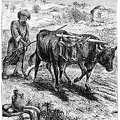The life of a farmer in Syria and Palestine is very different from the life of a farmer in England. He does not live in an isolated farmhouse, in the midst of a number of enclosed fields, which he owns or rents, and which he cultivates at his own cost and for his own profit alone. The country is much too unsettled to permit families to dwell alone, and so they cluster in little villages for their common safety and defence. The cultivated lands of the villagers lie outside the village, and the most fertile ground is sometimes a mile or two away from the houses. The villagers are too poor to enclose each a farm for himself, and the farms are simply cultivated plots lying unenclosed in a great waste, which belongs, perhaps, to the Government, or to some great feudal lord.
The ploughs used by these Syrian cultivators are little more than a bent wooden stock, having a long bar, by which it may be drawn. The lend of the stock is in shape somewhat like that which is formed by a human foot and leg, the foot being the 'share,' which scratches up the soil. That part which corresponds to the leg is prolonged upwards into a long handle, with the help of which the ploughman guides the plough. The bar by which the plough is drawn is attached to the inner or fore side of the bend, at the ankle, as it were. Two oxen of a small kind are, as a rule, attached to each plough.
- Author
- Chatterbox, 1906
Available from www.gutenberg.org - Posted on
- Sunday 27 December 2020
- Dimensions
- 900*497
- Albums
- Visits
- 1056
- Downloads
- 15
 Download Photo
Download Photo





